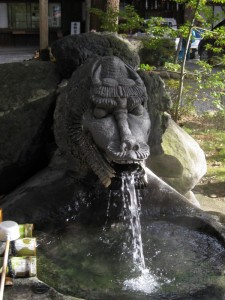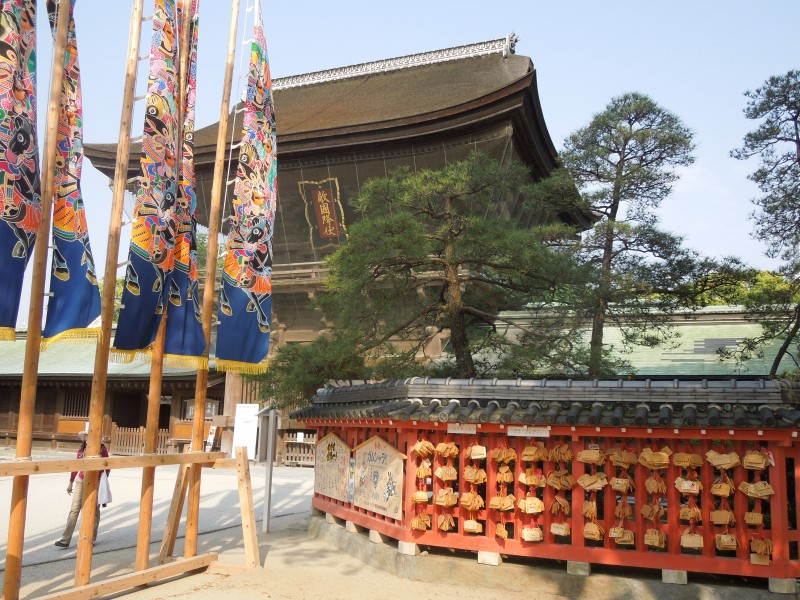An article in Japan Today details several traditional practices which involve cruelty to animals. Unfortunately Shinto shrines figure prominently among those holding and defending such practices. A nature religion? Or a religion of Japaneseness which includes the preservation of traditional ways?
********************
Adapted from Kuchikomi TOKYO —Sep. 30, 2015 Japan Today
In an article timed to coincide with “Be Kind to Animals Week” (Sept 20~27), Jun Mishina writes in Shukan Shincho about how activists are riding roughshod over tradition in order to safeguard the life, liberty and happiness of non-human members of the animal kingdom.

The water basin at Suwa Taisha, where animal sacrifice is still carried out not only in the form of frogs but of deer
In January of this year, the Suwa Grand Shrine in Suwa City, Nagano Prefecture, was beset by placard-bearing protesters, who were upset over a “frog-hunting ceremony”—a 1,000-year-old ritual that calls for capturing amphibians and impaling them with arrows, which are then offered to the gods. Presently, only two frogs are so sacrificed, with the impaling ritual taking place in the shrine’s inner sanctum and not in public. That, however, was enough to infuriate a dozen demonstrators, who disrupted the event with chants of “Cruel! Cruel!”
“What I found most objectionable was the female protester who waded into the Mitarai River and physically attempted to stop parishioners from catching frogs,” Masao Kasahara relates. “The shrine regards the spot in the river as a ‘sacred place’ where even the head priest isn’t permitted to enter. And there was this woman, yelling “Stop that!’ and ‘Don’t kill frogs!’ She was pushing so hard she slipped and fell into the river. That was a huge offense to the gods.”
Another assault on tradition has taken place at freak shows, some of which date back to feudal times. During festivals, people would set up as many as 300 tents on shrine grounds, where rubes could come to gawk at such spectacles as “The Human Pump,” “The Fire-spouting woman” and others. (Tokyoites can still see some of these at the Hanazono Shrine in Shinjuku during the “Tori-no-Ichi festival held every November.) But you’d better go soon, as their next act may be a vanishing act—literally.
The Hakozaki Shrine festival held every September in Fukuoka City has been beset upon by animal rights advocates, vociferously demanding that performances by the “hebi-onna” (snake woman) and “okami-onna” (wolf lady) be halted.

The entrance to Hakozaki Shrine in Fukuoka, where freak shows include biting the heads off chickens and snakes
The demonstrators were particularly incensed by a female geek who would bite the heads off live chickens and snakes. “That poor snake looks pitiful!” a protestor bellowed.
The demonstrators also persuaded two very reluctant patrolmen to accompany them to the venue. “The cops were saying, ‘If we go along, then the incident will be blown up out of proportion,’” said one of the freak show organizers. “Anyway, they did issue a warning to us, saying, ‘You’re not allowed to do anything illegal or you might get arrested.’”
“Nothing ever came to the point that the cops would walk on stage and make an arrest,” he continued. “But after that, we completely stopped using snakes. ‘Why did you stop?’ spectators were asking. But it couldn’t be helped. After that, we just don’t have the heart to keep doing it.”

Are foxes protected, for the sake of O-Kitsune Sama?
Or have I been completely misled by Lafcadio Hearn’s rose-tinted view of Japan?
Lafcadio Hearn certainly propagated a rose-tinted view in his publications, though if you read his letters you’ll get a different impression. As for foxes, there’s no chance of them being protected I’m afraid. There’s a clear divide in Japan between the cutification of animals in media terms (manga, anime etc) and what happens in reality. And religious symbolism does not have any bearing on real life. A glaring example is borne out by the shocking treatment of bears in the Ainu museum in Hokkaido. Don’t forget too that in Shinto horses are idealised as messengers of the kami, but that doesn’t stop them being abused in the Ageuma festival…